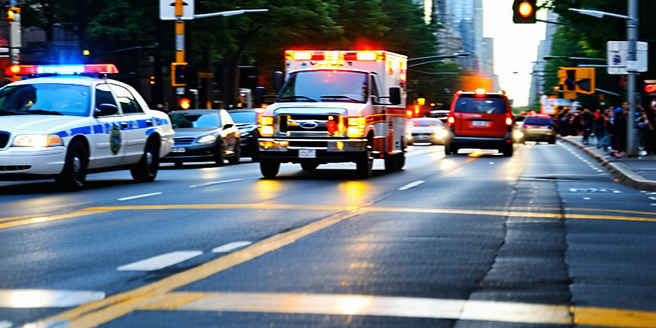
Understanding the Basics of Emergency Lanes
| Description | Purpose | Rules |
| Emergency lanes are specialized traffic lanes | Assist in rapid movement of emergency vehicles | Restricted to emergency situations only |
| Usually located adjacent to main traffic lanes | Provide a clear path to alleviate traffic delays | Strict penalties for misuse by regular vehicles |
| Marked with specific signage and road markings | Ensure timely arrival to emergency sites | Mandatory to yield for emergency access |
| Can be used by police, ambulances, and fire services | Support incident management | General vehicle access prohibited |
| Integrates with modern traffic management systems | Facilitate the most effective route during crises | Enforced by traffic legislation |
Common Incidents in Emergency Lanes
Emergency lanes are critical in ensuring emergency services reach destinations promptly. Common incidents often inhibit this purpose, ranging from illegal parking to distracted drivers encroaching on these lanes. Such misuse often results in delays for emergency response teams, raising the stakes during life-threatening situations. Vehicles breaking down or drivers misjudging their permitted use can further clutter these lanes. Enforcement measures, such as fines and towing, are often necessary to maintain the functionality of these critical pathways. Accurately categorizing these incidents is vital, as understanding the frequency and nature of these occurrences aids in crafting strategic responses. Public awareness campaigns have sometimes managed to alleviate the frequency of this issue, underscoring the importance of keeping these corridors clear and emphasizing legal and safety ramifications associated with improper use.
Legal Guidelines for Emergency Lane Usage
The legal framework governing emergency lanes is designed to prioritize safety and efficiency. Typically, these guidelines are enshrined in traffic legislation stipulating who may use these lanes and under what circumstances. Violation of such laws typically incurs heavy fines, and in severe cases, obstructing an emergency vehicle can result in criminal charges. Understanding these guidelines is crucial for all drivers. Education campaigns and driver training programs stress the sanctity of these lanes. It is important for drivers to stay informed about any updates to these regulations. Reinforcement through road signs helps remind drivers of the laws and the penalties associated with misuse. Clear comprehension of these guidelines helps ensure that emergency lanes remain available for their intended purpose.
Immediate Steps to Take During an Incident
Ensuring prompt response during an incident in the emergency lane requires an understanding of immediate actions to take. Firstly, drivers must check their surroundings and safely maneuver their vehicle out of the lane if possible. Activating hazard lights and signaling intentions to other road users is essential to prevent further incidents. Maintaining a calm demeanor during such a stressful situation can greatly aid in decision-making. If the vehicle is immobile, contacting emergency services for assistance should be a priority. Situational awareness and caution are necessary while waiting for help. In some cases, moving to a safer location is recommended if the situation allows, ensuring that the safety of passengers remains a priority while minimizing disruption to emergency services.
Coordinating with Emergency Services
Effective coordination with emergency services during an incident in the emergency lane can significantly alter outcomes. Immediate communication of the incident details, such as the location and severity, is necessary when contacting services. Clear and concise information helps responders prepare adequately before arriving at the scene. If assistance is requested via emergency hotlines, remain on the line unless instructed otherwise and follow guidance provided. Direct instructions might involve positioning flares or cones to demarcate the incident zone, facilitating improved navigation for incoming services. Information exchanges with onsite personnel once they arrive help optimize resource deployment. The seamless cooperation between road users and responders ensures lanes remain functional and responsive to evolving emergency scenarios.
Communication Tips for Drivers and Passengers
Clear communication between drivers and passengers during an emergency lane incident can prevent confusion and enhance safety. Drivers should calmly brief passengers on the current situation and provide instructions consistent with emergency protocols. It is also important to ensure that everyone remains as calm as possible to think clearly and follow instructions effectively. If a phone call to emergency services is required, assigning this task to a passenger can allow the driver to focus on managing the vehicle safely. Updates about the progress and resolutions should be shared to reduce anxiety and coordinate actions optimally. Incorporating communication strategies as part of regular road safety discussions can build familiarity and readiness, ensuring that all vehicle occupants understand their roles during emergency scenarios.
Safety Measures for On-the-Spot Handling
Proactive safety measures are indispensable when dealing with emergency lane incidents. Ensuring that every passenger is aware of these measures can significantly reduce panic and confusion. Relocating to a secure position is paramount where feasible, leveraging the vehicle’s safety features such as hazard lights and warning triangles to alert other road users of potential danger. In addition to these precautions, staying calm and assessing the situation is crucial. Reflective vests and torches should be part of an accessible emergency kit, increasing visibility during adverse weather or nighttime conditions. Avoid standing between traffic lanes, seeking shelter beyond barriers if necessary. Road safety measures are continuously advanced through research and real-time data analysis, conceived to preemptively manage incident scenes, emphasizing passenger and personnel well-being throughout the incident’s duration.
Documenting the Incident for Future Reference
Documenting incidents in emergency lanes provides vital information for developing preventative strategies and helping inform future protocols. Begin by taking photos or videos of the scene from safe vantage points to capture relevant details. Gathering statements from passengers and eyewitnesses adds supplementary perspectives. It’s important to remain calm and organized during the documentation process. Accurate documentation can significantly impact the understanding and resolution of such incidents. When authorities arrive, sharing this documentation aids investigations and facilitates accurate report filing. Electronic records, such as police reports or insurance filings, further ensure comprehensive documentation. Continual documentation aids in data collation, underpinning improvements to emergency lane management systems and reinforcing legal adherence across diverse scenarios.
Preventative Strategies to Avoid Incidents
Instituting preventative strategies to mitigate emergency lane incidents is an ongoing priority among traffic authorities. Public education campaigns raise awareness about the importance of keeping these lanes free and understanding applicable laws. Regular vehicle maintenance checks can help prevent breakdowns in these critical zones. Introducing incentives for compliance can also encourage drivers to adhere to these regulations. Engineering solutions, such as installing surveillance systems or automated alerts to monitor lane usage, provide oversight and thwart misuse. It is essential to continually assess the effectiveness of these measures to ensure they are having the desired impact. Behavioral interventions, like community-oriented initiatives encouraging legal adherence, can foster collective responsibility. Periodic evaluations of these strategies ensure they remain adaptive to changing traffic behaviors and infrastructural developments, minimizing resource allocation issues.
Reviewing Lessons Learned and Best Practices
Analyzing incident outcomes and best practice reviews fortify emergency lane management protocols. Gathering real-world experiences provides crucial insights into the effectiveness of current measures and highlights areas for enhancement. Regular engagement with stakeholders ensures that evolving traffic patterns are considered in strategy development. Stakeholders, including traffic authorities, emergency services, and public road users, contribute to crafting comprehensive strategies that anticipate challenges. Collaborative discussions among these stakeholders often lead to innovative solutions for complex scenarios. Successful interventions are documented as case studies, serving as learning templates for other regions. Best practices include structured information dissemination, rigorous training modules, and periodic scenario drills. Through this reflective approach, emergency lane management evolves, ensuring optimized resource deployment and preparedness, safeguarding critical pathways during emergencies.

